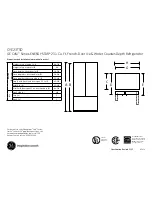
22
Eliminating minor faults yourself
Before you call customer service:
Please check whether you can eliminate the fault yourself based on the following information.
Customer service will charge you for advice
–
even if the appliance is still under guarantee!
Appliance
Fault
Possible cause
Remedial action
Appliance has no refrigeration
capacity.
The light does not work.
The display does not illuminate.
Appliance has been switched off.
Press the On/Off button.
Power failure.
Check whether the power is on.
The fuse has been switched off.
Check the fuse.
The mains plug has not been inserted
properly.
Check whether the mains plug is secure.
The refrigeration unit is switching
on more frequently and for lon-
ger.
Appliance opened frequently.
Do not open the appliance unnecessarily.
The ventilation openings have been cov-
ered.
Remove obstacles.
Large quantities of fresh food are
placed in the freezer.
Activate fast cooling and/or fast freezing.
The temperature in
the refrigerator compartment
or freezer compartment is too
cold.
Temperature has been set too low.
Increase the temperature (see chapter Select-
ing the temperature).
The light (LED) does not work.
The LED lamp is defective.
Call customer service.
Light switch is jammed.
Check whether it can be moved.
You experience unpleasant
odours.
Strongly smelling food is not sealed.
Clean the appliance. Seal strongly smelling
food (see chapter “Odours”).
Display indicates “E..”.
Electronics have detected a fault.
Call customer service.
Display indicates “LOW-
POWER”.
The mains voltage falls below
the permitted limiting value.
When the mains voltage reaches the stipulated
value again, the warning message goes out.
If the warning message lasts for longer, inform
the energy supply company.
Display indicates “HIGHVOLT”.
The mains voltage exceeds
the permitted limiting value.
When the mains voltage reaches the stipulated
value again, the warning message goes out.
If the warning message lasts for longer, inform
the energy supply company.
Condensation forms on the rail
on the left door.
Condensation of warm air.
Switch on heater in the rail (see chapter “Spe-
cial functions”, section “Door rail heater”).
















































